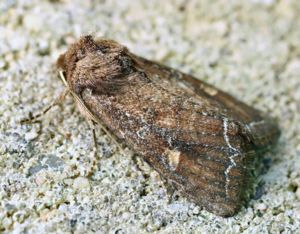Vegetable owl
| Vegetable owl | ||||||||||||
|---|---|---|---|---|---|---|---|---|---|---|---|---|

Vegetable Owl ( Lacanobia oleracea ) |
||||||||||||
| Systematics | ||||||||||||
|
||||||||||||
| Scientific name | ||||||||||||
| Lacanobia (Diataraxia) oleracea | ||||||||||||
| ( Linnaeus , 1758) |
The vegetable owl ( Lacanobia (Diataraxia) oleracea ) is a butterfly ( moth ) from the family of the owl butterflies (Noctuidae).
features
The moths of the vegetable owl reach a wingspan of 35 to 40 millimeters. The front wings have a brown-red, the rear wings a light reddish basic color. Butterflies with yellow-red forewings are called f. rufa Tutt. designated, moths with black-brown forewings as f. obscura winder. The transverse lines are indistinct and can also be completely absent. There is a gray ring flaw and a reddish-yellow kidney flaw on the forewings . The white W-drawing extends to the edge of the wing.
The egg is hemispherical with a flattened base. It is initially colored light green; it later turns dark green to ash gray. The surface has irregular longitudinal ribs.
The caterpillars reach a length of up to 45 millimeters. Their body color is very variable, it ranges from green to brown, gray and pink. In addition to a fine white speckle, there is a broad, pale yellow to white substigmatic line. The head is yellowish or greenish brown and has a pale pattern.
The doll is dark red-brown. It has a pointed cremaster that has two pointed bristles.
Similar species
There is a risk of confusion with the mutable herb owl ( Lacanobia suasa ) and the pea owl ( Ceramica pisi ).
Geographical distribution and habitat
The vegetable owl is widespread in Europe. The populated area extends from North Africa over the Iberian Peninsula through all of Europe to Japan . The limits of the distribution run in the north through central Fennoscandia and in the south from the Maghreb countries to the Middle East and Central Asia . The vegetable owl is a cultural successor and mainly populates cultivated land such as gardens, parklands and fallow land where suitable forage plants grow. It can also be found in swamp forests , valley floors and floodplains .
Way of life
The vegetable owl forms one generation a year. Occasionally a second generation is observed, but it is incomplete. The moths can be found from mid-May to late July (first generation) and from early August to mid-September (second generation). The moths like to come to light and can also be observed on different flowers ( Canadian goldenrod ( Solidago canadensis ), common water deast ( Eupatorium cannabinum ), bindweed ( Calystegia spec.), Butterfly lilac ( Buddleja davidii )). They are also often found on the bait. The females lay the green colored eggs on suitable forage plants. The caterpillars hatch after about a week. The caterpillar season lasts from September to mid-October (first generation) and from early August to mid-September (second generation). The generations overlap very strongly. They are nocturnal and hide at the base of their forage plants during the day. Occasionally they can also be found stretched out on leaves during the day, where they sunbathe. The caterpillars of the vegetable owl live polyphagously on the following herbaceous plants and shrubs, among others:
- Cabbage ( Brassica spec.)
- Tomato ( Solanum lycopersicum )
- Lettuce ( Lactuca spec.)
- Pea ( Pisum sativum )
- Sloe ( Prunus spinosa )
- Common heather ( Calluna vulgaris )
- Goosefoot ( Chenopodium spec.)
- Report ( Atriplex spec.)
- Nettles ( Urtica spec.)
- Dock ( Rumex spec.)
- Common clematis ( Clematis vitalba )
- Garden hydrangea ( Hydrangea macrophylla )
- Currants ( Ribes spec.)
- Lupins ( Lupinus spec.)
- Cyclamen ( Cyclamen spec.)
- Paprika ( Capsicum annuum )
- Lesser toadflax ( Chaenorhinum minus )
- Mugwort ( Artemisia spec.)
The caterpillars moult five to six times. Pupation takes place after about 30 to 40 days in an underground cocoon. The species overwinters as a pupa.
pest
The vegetable owl can cause damage in commercial vegetable growing and horticulture. However, its importance as a field pest has declined significantly due to the use of insecticides .
Systematics
The genus Lacanobia is described by Hacker et al. (2002) divided into three sub-genera. Lacanobia oleracea is added to the subgenus Diataraxia Hübner, 1821.
swell
Individual evidence
- ↑ a b c Manfred Koch : We determine butterflies. Volume 3: Owls. 2nd, expanded edition. Neumann, Leipzig / Radebeul 1972, DNB 760072930 .
- ^ A b Walter Forster , Theodor A. Wohlfahrt : The butterflies of Central Europe. Volume 4: Owls. (Noctuidae). Franckh'sche Verlagshandlung, Stuttgart 1971, ISBN 3-440-03752-5 .
- ↑ a b c d e f David J. Carter, Brian Hargreaves: Caterpillars and butterflies of Europe and their forage plants. Blackwell Wissenschaftsverlag 1987, ISBN 3-826-38139-4
- ↑ Axel Hausmann, Michael A. Miller: Atlas of the caterpillars of European and Asia Minor butterflies, photographed by Burkhard Nippe , Verlag Dr. Friedrich Pfeil, Munich, 2000, ISBN 3-931-51679-2
- ↑ a b c d e f g h i j k l m n o p Günter Ebert (ed.): The butterflies of Baden-Württemberg Volume 7, Nachtfalter V (Eulen (Noctuidae) 3rd part), Ulmer Verlag Stuttgart 1998. ISBN 3-800-13500-0
- ↑ Bernard Skinner: Color Identification Guide to Moths of the British Isles , Penguin UK 1999, ISBN 0-670-87978-9
Web links
- www.lepiforum.de Taxonomy and photos
- www.schmetterling-raupe.de
- www.insektenbox.de
- Lacanobia oleracea at Fauna Europaea
- Moths and Butterflies of Europe and North Africa (English)
- Ian Kimber: Guide to the moths of Great Britain and Ireland (English)
- The Larger Moths of Suffolk (English)

